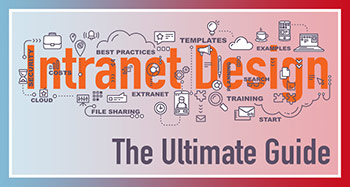You’ve googled ‘intranet’ and have found a couple of options that look promising. You watch the demo videos and it all seems so easy. Setting up an intranet can’t be that difficult you say to yourself and so you dive in head first, promising staff that the answer to all the organization’s problems will be delivered in a few days. If this sounds like you, then our advice is STOP! While it is certainly true that setting up an intranet is a simpler process than you might think, and tempting though it is to press ahead, it’s important to make sure you have carefully thought through what’s involved. Rushing into an implementation without adequate preparation is often a reason for long-term failure. So, in this post, we examine all the factors you need to consider before diving into intranet project management. After all, the key to success in business is planning and preparation.
Intranet Project Management: What’s Involved?
Elsewhere in this blog, we look in detail at what’s involved in implementing an intranet. Here though is a short summary of the steps you need to take. Each step has a time and resource implication that you will need to consider carefully.
1. Aims And Objectives
What is it that you want your intranet to achieve? Most businesses are spurred into action in response to an identified organizational pain point. It could be a desire to improve internal communications, a need to enhance employee engagement or wanting to do away with paper and email processes with automated online ones. Whatever the case may be, it’s important you brainstorm precisely what the aims and objectives are for the intranet. Without that clear vision and sense of direction, it’s difficult to know whether your intranet is a success or not.
2. Intranet Design

3. Intranet Content
As well as written content, you will also want to consider images, graphics and any videos. Thought needs to be given as to how the content will be organized so that it’s easy for staff to find what they are looking for. An overall site map is essential and it may be that your intranet is organized by teams, departments or perhaps by product or service – whatever makes sense to your company. Be mindful of the intranet search function and how information will be classified and tagged to enable discovery.
Content on the best intranets tends to be clear, concise and engaging and is presented in bite-sized chunks. Graphics and images are important as they make the intranet visually appealing and add color. Both written and visual content needs to be reviewed and refreshed on a regular basis. Deciding on the content isn’t just a one-off job. There will be an ongoing time commitment involved in keeping the content relevant and up to date.
4. Pilot The Intranet
Once you’ve decided on a basic structure and have added in content, it’s time to pilot the intranet. Even with thorough planning and preparation, it’s unlikely that you will get everything right first time around. Testing how it’s working in practice is, therefore, an essential step as it will reveal things that need to be tweaked. And making adjustments at this stage is a much simpler prospect than doing so after the go-live date.
5. Staff Training

6. Ongoing Intranet Project Review
As we’ve seen, implementing the intranet is only the start! To be successful in the long term, the intranet needs to be properly managed and maintained. How will new users be added in your company? And how will former employees be deleted? Who will have responsibility for reviewing and updating content? And what about regularly checking up on the intranet’s aims and objectives to ensure it’s still working for the business? These are all considerations that need to be thought through and planned for. Many a great intranet has ultimately failed because the company didn’t pay sufficient attention to the post-implementation phase.
Intranet Deployment: Time Commitment
So, how much time are we talking about? Well, you could rush through all the steps we have identified here and have a fully functioning intranet up and running in a matter of just a few weeks or even days. But will it be fit for purpose? Will it solve those important pain points that are holding your business back? And the truth is, it’s debatable whether a hastily deployed intranet will indeed be the solution you are looking for. In fact, you could be storing up a whole heap of hassle in the long run as you grapple with addressing the intranet’s shortcomings. It’s far better to take your time inadequately preparing and project planning an intranet that will satisfy those needs while also standing the test of time.

The initial time commitment to support the intranet’s deployment will be added to as ongoing management and maintenance tasks kick in. We estimate that keeping the content updated, adding new content and pages, managing users, as well as access rights, could take up to an hour a day. Again this task can be shared across the organization. Individual staff members in teams can be identified as departmental page owners and have responsibility for managing their own areas, content and users.
So, while there are ways to share the burden, it’s important not to underestimate the time commitment involved. The bottom line is if you cannot afford to invest 40-80 hours in your intranet deployment project just now, then it’s probably best not to press ahead with a half-baked proposal. Alternatively, you could try using some of the following time-saving tips which will see you get your intranet off the ground as quickly as possible.
Intranet Project Management: Time-Saving Tip #1
Utilize cloud-hosted intranet templates. Most SaaS or cloud-based intranet providers utilize a system of fully customizable intranet templates. From a menu of available tools and features, you select the ones relevant to your business. It could be news blogs and newsletters, secure document and file storage, company calendars, employee directories, online forms and workflows, collaborative workspaces or social intranet features. Some or only a few of these may be relevant to your business, but the intranet template model gives you complete freedom over selection as well as the ability to customize the template with your unique stamp, company colors and branding.

Intranet templates are also super easy and intuitive to use and don’t require any great technical know-how. This is a distinct advantage if you do not have any dedicated internal IT resource or technology isn’t really your thing. All you need to do is simply drag and drop the functionality and content into your secure custom intranet template. It’s as simple and straightforward as that. And if you happen to get into difficulty and require a helping hand, then the cloud intranet provider offers ongoing support at no additional cost during the implementation phase.
Intranet Project Management: Time-Saving Tip #2
Utilize a cloud provider’s design service. Even with the time-saving tips we’ve already identified in this article, deploying an intranet can still be a stretch for some companies. It may be that the company has only a handful of employees, or perhaps all personnel are already working at full capacity developing the business. For some companies, it’s more a case of having an urgent need for an intranet but a lack of time to get things up and running. If this scenario applies to you, then utilizing a cloud provider’s design service could well be the solution you need. The designer will work closely with you to ensure that the intranet is a perfect match to your needs and requirements as well as satisfying budgetary and time constraints. The designer will support you in terms of:
developing the scope and commercials including objectives and a sitemap
- creating the design, developing pages, content both text and visuals, as well as adding users and assigning access rights
- launching the intranet and supporting you through handover, staff training and post-launch support.
The design service is a comprehensive and cost-effective solution for time-poor executives that need to act fast.
Finally, A Word About Costs
Of course, time isn’t the only consideration for most businesses. The overall cost is just as important. And cloud-hosted intranet templates have a number of advantages here too. You see, cloud providers offer cost certainty. Most operate on a subscription model which means a fixed monthly fee and complete clarity over the available services. As well as access to intranet templates, ongoing support, unlimited users and data storage, the monthly fee also covers all the very latest security measures from firewalls through to anti-virus software, malware and SSL.
In addition, there is no ongoing expensive maintenance of company servers to worry about. And cloud providers also offer high availability and uptime (typically 99.9 percent) as well as automatic backups and updates.
The truth is there are plenty of hidden costs involved in a do-it-yourself intranet that can easily see costs spiral out of control and beyond budgetary expectations. Cloud intranet options, however, provide greater transparency and cost certainty.
Cloud-Hosted Intranet Templates: The Sensible Choice
So, if you’re after a time-saving, cost-effective and hassle-free intranet deployment, then there really is only one choice: cloud-hosted intranet templates. Super easy to set up and manage on an ongoing basis, intranet templates are fully customizable and also offer the security of the help and support of the provider and a dedicated design service. So take the stress and uncertainty out of the process. Get in touch with the expert team here at MyHub and check out the possibilities with our free online demo or no obligation 14-day trial.


 developing the scope and commercials including objectives and a sitemap
developing the scope and commercials including objectives and a sitemap





0 Comments